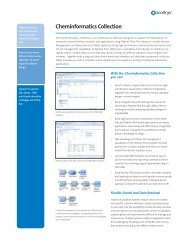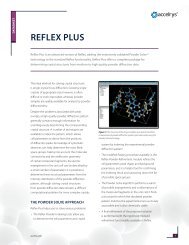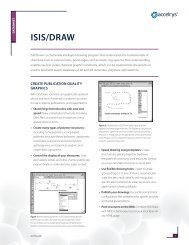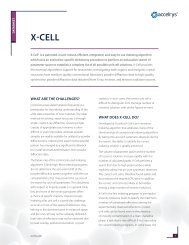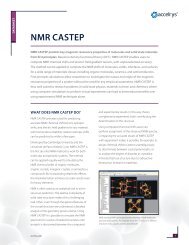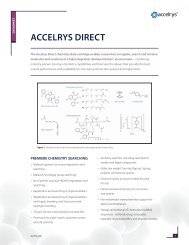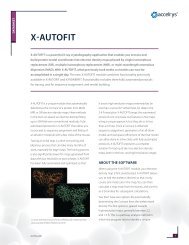SIMulatIon of non-IonIC SurfaCtant MICelleS for ... - Accelrys
SIMulatIon of non-IonIC SurfaCtant MICelleS for ... - Accelrys
SIMulatIon of non-IonIC SurfaCtant MICelleS for ... - Accelrys
Create successful ePaper yourself
Turn your PDF publications into a flip-book with our unique Google optimized e-Paper software.
CASE STUDY<br />
<strong>SIMulatIon</strong> <strong>of</strong> <strong>non</strong>-<strong>IonIC</strong> <strong>SurfaCtant</strong><br />
<strong>MICelleS</strong> <strong>for</strong> Controlled drug releaSe<br />
Modules used<br />
• Materials Studio® DPD<br />
• Material Studio® Discover<br />
• Material Studio® COMPASS<br />
• Material Studio® Amorphous Cell<br />
Services used<br />
• Contract Research Services<br />
Industry Sectors<br />
• Drug Delivery<br />
Contributors<br />
• David Rigby, Contract<br />
Research Services, <strong>Accelrys</strong><br />
• Franck Pitré, Galderma<br />
accelrys.com<br />
Multi-scale modeling is a key approach to solving complex<br />
challenges such as the delivery <strong>of</strong> active substances in a<br />
transdermal skin <strong>for</strong>mulaiton. Materials studio with its dissipative<br />
aprticel dynamics is akey anbler <strong>of</strong> multi scale modeling<br />
Researchers from Galderma and <strong>Accelrys</strong> have collaborated to apply a multiscale<br />
modeling approach to the study <strong>of</strong> the stability <strong>of</strong> micellar systems <strong>for</strong> the<br />
controlled release <strong>of</strong> a drug.<br />
Galderma is a pharmaceutical company<br />
specializing in dermatological treatments.<br />
They have significant interest in applying<br />
new technologies to better understand the<br />
behavior <strong>of</strong> topical drug <strong>for</strong>mulations. In<br />
particular, there is a need to understand the<br />
underlying cause <strong>of</strong> physical and chemical<br />
instability <strong>of</strong> a drug used in a particular type<br />
<strong>of</strong> <strong>for</strong>mulation. This instability is speculated<br />
to be attributed to the location <strong>of</strong> the<br />
drug in relation to the interface between<br />
micellar microphases present in the system.<br />
Since it is not always possible to obtain<br />
these data experimentally Galderma R&D<br />
leveraged the expertise <strong>of</strong> <strong>Accelrys</strong>’ Contract<br />
Research Services to gain insight into the<br />
nature <strong>of</strong> the molecular distribution <strong>of</strong><br />
the different species within the micelles.<br />
BaCkground In<strong>for</strong>MatIon:<br />
Surfactants are molecules that have<br />
amphiphilic character, i.e., they have both<br />
hydrophilic and hydrophobic groups,<br />
rendering them soluble in organic<br />
solvents as well as in water. When the<br />
surfactant concentration in a solution<br />
is higher than a critical concentration<br />
(CMC), the surfactant molecules <strong>for</strong>m<br />
supramolecular aggregates called micelles.<br />
Micelles are commonly used as drug<br />
delivery devices to solubilize hydrophobic<br />
drug molecules or to protect them from<br />
environmental conditions (e.g., gastric<br />
acid). For the delivery system to succeed,<br />
favourable interactions between the drug<br />
and the surfactant are necessary. These<br />
interactions, as well as the morphology<br />
<strong>of</strong> the resulting micellar solutions, can<br />
be modified by the presence <strong>of</strong> new<br />
molecules as well as by changes in<br />
the solvent quality or temperature.<br />
1
oBjeCtIve:<br />
The objectives <strong>of</strong> this work were to gain insight on the<br />
localization <strong>of</strong> different molecules incorporated into<br />
the micelles, and on the influence <strong>of</strong> the <strong>for</strong>mulation<br />
on the final morphology <strong>of</strong> the solutions.<br />
Methodology:<br />
Following the use <strong>of</strong> atomistic modeling to estimate the<br />
thermodynamic properties <strong>of</strong> the <strong>non</strong>-ionic surfactant<br />
and the drug (Materials Studio® Discover and COMPASS<br />
<strong>for</strong>cefield), a suitable coarse-grained model <strong>for</strong> the<br />
surfactants, the drug molecule and the solvents were<br />
generated (Figures 1 and 2). Mesoscale modeling was then<br />
per<strong>for</strong>med to study the morphology <strong>of</strong> five simple systems<br />
with increasing complexity (Materials Studio® DPD®):<br />
• Non-ionic surfactant in water solution<br />
• Non-ionic surfactant and hydrophobic drug in water solution<br />
• Non-ionic surfactant, hydrophobic drug<br />
and polar solvent in water solution<br />
• Non-ionic surfactant, hydrophobic drug, preservative<br />
and polar solvent in water solution<br />
• Non-ionic surfactant, hydrophobic drug and <strong>non</strong>-ionic<br />
polymeric surfactant in water solution<br />
reSultS:<br />
For the system consisting <strong>of</strong> the <strong>non</strong>-ionic surfactant in<br />
aqueous solution, a micellar solution was obtained (Figure 3).<br />
The size <strong>of</strong> the micelles was found to be nearly independent<br />
<strong>of</strong> the temperature and <strong>of</strong> the surfactant concentration in<br />
the range 1% to 4%. As the drug was added to the system,<br />
the micelle size was reduced, with the drug concentrating<br />
at the core-corona interface. Additionally, the impact <strong>of</strong> the<br />
solvent quality was studied and it was found that under worst<br />
solvent conditions, the drug diffused out <strong>of</strong> the micelle.<br />
accelrys.com<br />
CASE STUDY: MATEriAlS STUDio<br />
figure 1. Atomistic model <strong>of</strong> the <strong>non</strong>-ionic surfactant molecule.<br />
figure 2. Coarse-grained model <strong>of</strong> the <strong>non</strong>-ionic surfactant molecule.<br />
figure 3. Surfactant micelle in aqueous solution (water<br />
not shown).<br />
2
On the other hand, when adding a polar solvent, the solvent<br />
molecules remained outside the micelles, whereas the drugs<br />
tended to spread throughout the corona-core interface (Figure 4).<br />
The simulation was repeated incorporating a well-known<br />
preservative. The results indicated that the preservative migrated<br />
to the micellar corona, counteracting the impact <strong>of</strong> the polar<br />
solvent with respect to the drug, which was located slightly<br />
closer to the centre <strong>of</strong> the micelle (Figure 5) compared to the<br />
previous systems. Higher concentrations <strong>of</strong> the preservative led<br />
to unstable systems, a fact that was validated experimentally.<br />
When a polymeric <strong>non</strong>-ionic surfactant was added, no<br />
major changes where observed with respect to the drug,<br />
with the active ingredient remaining inside the micelle<br />
and located at the corona-solvent interface. Additionally<br />
however, bridging between the micelles was observed, as<br />
strands <strong>of</strong> the polymeric surfactant showed the capability<br />
to extend between adjacent micelles (Figure 6). This is a<br />
condition which may lead to flocculation and precipitation.<br />
SolutIon to the Challenge:<br />
A multiscale modeling approach was used to better<br />
understand the behavior <strong>of</strong> topical drug <strong>for</strong>mulations. This<br />
study demonstrated that molecular simulations per<strong>for</strong>med<br />
by an expert can provide insights on the degree <strong>of</strong> stability <strong>of</strong><br />
different <strong>for</strong>mulations as well as on the changes in the molecular<br />
distribution within the micelles after the incorporation <strong>of</strong><br />
hydrophobic active principles, aqueous co-solvents and <strong>non</strong>ionic<br />
surfactants at different temperatures. The Dissipative<br />
Particle Dynamics simulation results obtained agreed with the<br />
experimental data and in addition provided important molecular<br />
in<strong>for</strong>mation that can not be obtained from experiments.<br />
To learn more about Materials Studio by <strong>Accelrys</strong>, go to<br />
accelrys.com/materials-studio<br />
accelrys.com © 2011 <strong>Accelrys</strong> S<strong>of</strong>tware Inc. All brands or product names may be trademarks <strong>of</strong> their respective holders.<br />
CASE STUDY: MATEriAlS STUDio<br />
figure 4. Radial concentration pr<strong>of</strong>iles <strong>for</strong> the system<br />
containing <strong>non</strong>-ionic surfactant, hydrophobic drug, and<br />
polar solvent (PG) in water solution . Core and EO stand <strong>for</strong><br />
hydrophobic tail and polar head <strong>of</strong> the surfactant respectively.<br />
figure 5. Radial concentration pr<strong>of</strong>iles <strong>for</strong> the system<br />
containing <strong>non</strong>-ionic surfactant, hydrophobic drug,<br />
preservative (BA) and polar solvent (PG) in water solution.<br />
Core and EO stand <strong>for</strong> hydrophobic tail and polar head<br />
<strong>of</strong> the surfactant respectively.<br />
figure 6. Snapshot <strong>of</strong> the system containing <strong>non</strong>ionic<br />
surfactant, hydrophobic drug and <strong>non</strong>-ionic<br />
polymeric surfactant in aqueous solution (water<br />
not shown).<br />
CS-8036-1211<br />
3



